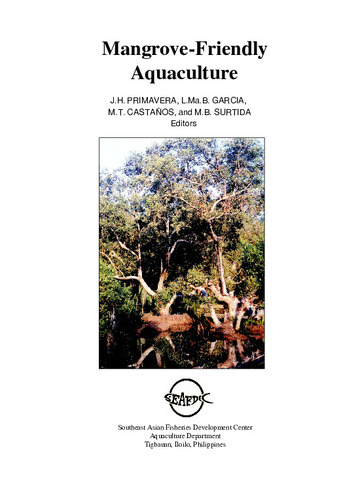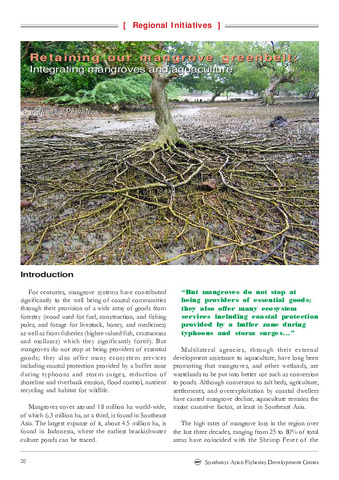Paradigm shifts in mangrove rehabilitation in Southeast Asia: Focus on the Philippines
- Global styles
- MLA
- Vancouver
- Elsevier - Harvard
- APA
- Help

View/
Date
2014Author
Page views
2,540ASFA keyword
AGROVOC keyword
Taxonomic term
Metadata
Show full item record
Share
Abstract
Mangrove rehabilitation has a long history in the Philippines dating back to the 1930s. The standard practice is the planting of bakhaw Rhizophora propagules by paid community members (or volunteers) in seafront sites selected during spring low tides. In 2009, the Community-based Mangrove Rehabilitation Project (CMRP) of the Zoological Society of London was established to: (a) rehabilitate abandoned government-leased fi shponds into healthy mangroves; (b) increase coastal protection, food resources, and livelihood income through sustainable management of mangroves; and (c) re-establish the legally mandated mangrove ‘greenbelt’ along the coast.
Over four years, the CMRP has planted the following in various partner sites in Panay and Guimaras: (a) 58,000 seeds or wildings bagged in nurseries by 3,000 participants, and (b) 99,000 seedlings/wildings outplanted by 4,000 planters in ~20 ha of greenbelts and abandoned ponds. The species are mainly bungalon/piapi Avicennia marina, pagatpat Sonneratia alba, and to a lesser extent, bakhaw Rhizophora. The planters include high school/college students and teachers, members of people’s organizations, barangay and municipal government employees, BFAR and DENR staff , and civil society organizations. The extensive CMRP trials have yielded signifi cant learnings, many of them paradigm shifts from present protocols, as included in the 20 Golden Rules of Mangrove Rehabilitation. A manual that documents these learnings with concrete examples based on CMRP monitoring of fi xed quadrats and other standardized protocols, is currently in press. Some of these protocols are the following: (a) planting site: shift from seafront sites to abandoned ponds (whenever possible); (b) time of site selection: during (low tide of) Neap Tide rather than Spring Tide; (c) species selection for seafront sites: the ecologically correct bungalon/piapi and pagatpat, rather than the easy-to-plant but unsuitable bakhaw; (d) sources of planting materials: use of available wildings is harvesting nature’s excess (equivalent to withdrawing from ‘seedling banks’), which also saves time; (e) labor: “No Pay” planting is based on the premise that labor contributed by the community provides the basis for ownership, thereby obligating them to nurture the plants to maturity and validating their role as de facto managers of mangrove resources.
Similar mangrove initiatives have been observed elsewhere in Southeast Asia, as follows: (a) barriers/breakwater in MaIaysia, Vietnam, and Thailand; (b) use of wildings in Malaysia; and (c) mangrove ecoparks/reserves in Singapore, Thailand, Vietnam and Brunei.
Suggested Citation
Primavera, J. H., Guzman, A. M. T., Coching, J. D., Loma, R. J. A., Curnick, D., & Koldewey, H. J. (2014). Paradigm shifts in mangrove rehabilitation in Southeast Asia: Focus on the Philippines. In H. G. Palis, S. A. Pasicolan, & C. I. Villamor (Eds.), Proceedings of the 1st ASEAN Congress on Mangrove Research and Development, 3-7 December 2012, Manila, Philippines (pp. 17-30). Manila, Philippines: Department of Environment and Natural Resources - Ecosystems Research and Development Bureau (DENR-ERDB).
Type
Conference paperCollections
- Conference Proceedings [299]
Related items
Showing items related by title, author, creator and subject.
-
Mangroves as nurseries: Shrimp populations in mangrove and non-mangrove habitats
Primavera, J. H. (Elsevier, 1998)A total of 4845 penaeids belonging to nine species—Metapenaeus anchistus, M. ensis, M. moyebi, M. philippinensis, Penaeus merguiensis, P. monodon, P. semisulcatus, P. latisulcatus and Metapenaeopsis palmensis—were collected ... -
Mangrove-Friendly Aquaculture : Proceedings of the Workshop on Mangrove-Friendly Aquaculture organized by the SEAFDEC Aquaculture Department, January 11-15, 1999, Iloilo City, Philippines
Primavera, Jurgenne H.; Garcia, Luis Ma. B.; Castaños, Milagros T.; Surtida, Marilyn B. (Aquaculture Department, Southeast Asian Fisheries Development Center, 2000)The proceedings have three review papers on the mangroves of Southeast Asia, silvofisheries, and Indonesia's integrated mangrove forest and aquaculture systems. The rest of the papers, all on mangrove-friendly aquaculture ... -
Retaining our mangrove greenbelt: Integrating mangroves and aquaculture
Although multilateral agencies in Southeast Asia have long been promoting that mangroves, and other wetlands, are wastelands to be put into better use, such as conversion to ponds. However, there is a need for Mangrove ...






